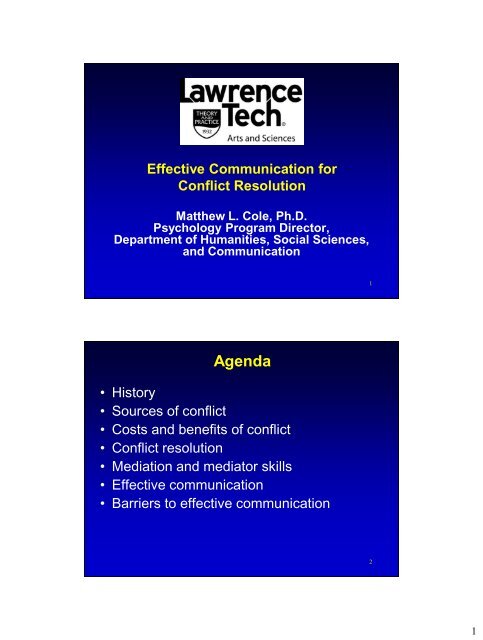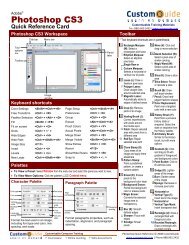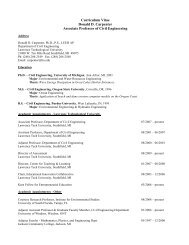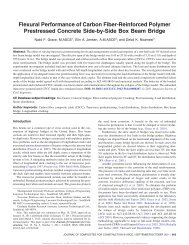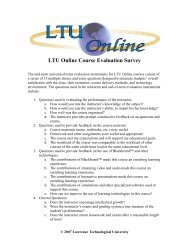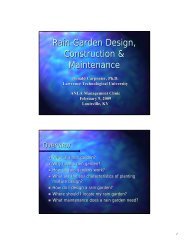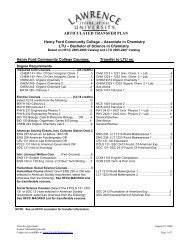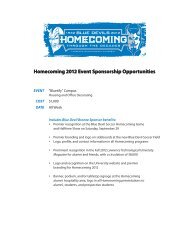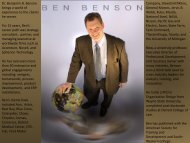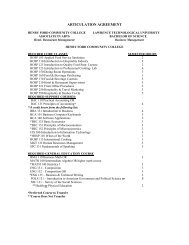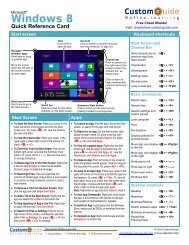Effective communication for conflict resolution and mediation
Effective communication for conflict resolution and mediation
Effective communication for conflict resolution and mediation
You also want an ePaper? Increase the reach of your titles
YUMPU automatically turns print PDFs into web optimized ePapers that Google loves.
<strong>Effective</strong> Communication <strong>for</strong><br />
Conflict Resolution<br />
Matthew L. Cole, Ph.D.<br />
Psychology Program Director,<br />
Department of Humanities, Social Sciences,<br />
<strong>and</strong> Communication<br />
1<br />
Agenda<br />
• History<br />
• Sources of <strong>conflict</strong><br />
• Costs <strong>and</strong> benefits of <strong>conflict</strong><br />
• Conflict <strong>resolution</strong><br />
• Mediation <strong>and</strong> mediator skills<br />
• <strong>Effective</strong> <strong>communication</strong><br />
• Barriers to effective <strong>communication</strong><br />
2<br />
1
History of Conflict Resolution<br />
• In thinking about <strong>and</strong> practicing <strong>conflict</strong> <strong>resolution</strong>,<br />
it’s useful to have some historical framework:<br />
– In 1946, social psychologist Kurt Lewin, then<br />
Director of MIT’s Research Center <strong>for</strong> Group<br />
Dynamics, started Training Groups that<br />
advocated open-minded appreciation <strong>and</strong><br />
inclusion of differences.<br />
– Also in 1946, the US Office of Naval Research<br />
<strong>and</strong> the National Education Association funded<br />
the National Training Laboratory <strong>for</strong> Applied<br />
Behavioral Science (NTL).<br />
3<br />
History of Conflict Resolution<br />
– In 1960s, Lewin (now at Yale University)<br />
collaborated with NTL to apply <strong>conflict</strong> <strong>resolution</strong><br />
to workplaces.<br />
– In the 1970s, <strong>mediation</strong>—an alternative to<br />
litigation—was introduced as a non-coercive,<br />
interest-based, facilitated process to resolve<br />
<strong>conflict</strong>.<br />
– The history of <strong>mediation</strong> as a self-help skill in<br />
workplaces begin in 1980 with an article by<br />
Daniel Dana on managerial <strong>mediation</strong>.<br />
4<br />
2
Conflict: Defined<br />
• To learn how to resolve <strong>conflict</strong>, we first need to<br />
know what <strong>conflict</strong> is so that we do not use an<br />
excellent tool to fix the wrong problem, <strong>for</strong> example,<br />
the carpenter who tries to drive a nail with a<br />
screwdriver.<br />
• A <strong>conflict</strong> involves a condition between or among<br />
workers, whose jobs are interdependent, who feel<br />
angry, who perceive the other as being at fault, <strong>and</strong><br />
who act in ways that cause a problem at work.<br />
5<br />
Conflict: Defined<br />
• Conflict often occurs when there is an emotional<br />
disagreement between two or more people about<br />
policies, process, activities or outcome.<br />
• It is easy to confuse <strong>conflict</strong> with the decision,<br />
disagreement, stress, or other common experiences<br />
that may cause, or be caused by, <strong>conflict</strong>—these<br />
are not <strong>conflict</strong>, <strong>and</strong> they are not best h<strong>and</strong>led by<br />
<strong>conflict</strong> <strong>resolution</strong> tools.<br />
6<br />
3
Sources of Conflict<br />
• Poor <strong>communication</strong><br />
• Competition/rivalry<br />
• Authority not defined<br />
• Different viewpoints<br />
• Limited resources<br />
• Value/generational/cultural differences<br />
• Aggressive, insecure individuals<br />
7<br />
Costs of Conflict<br />
• Destroys professional relationships<br />
• Creates barriers to individual <strong>and</strong><br />
organizational effectiveness<br />
• Derails teamwork<br />
• Creates enemies <strong>and</strong> hidden agendas<br />
• Adds stress to the workplace<br />
• Wastes time, money <strong>and</strong> resources<br />
• Affects the ability to stay competitive<br />
8<br />
4
Benefits of Conflict<br />
• Helps increase strength <strong>and</strong> cohesion<br />
• Provides a safety valve function<br />
• Helps clarify issues <strong>and</strong> goals<br />
• Improves relationships<br />
• Fosters improved <strong>communication</strong><br />
• Triggers innovation <strong>and</strong> creativity<br />
• Becomes a major cause of organizational<br />
change<br />
9<br />
Conflict Resolution<br />
• Conflict <strong>resolution</strong> is a process of working<br />
through opposing views in order to reach a<br />
common goal or mutual purpose.<br />
• At the heart of <strong>conflict</strong> <strong>resolution</strong> is effective<br />
<strong>communication</strong>.<br />
• With effective <strong>communication</strong>, participants<br />
are able to:<br />
– Express their initial positions<br />
– Explore the underlying concerns<br />
– Determine mutually acceptable solutions<br />
10<br />
5
Conflict Resolution Styles<br />
• Competing<br />
– Relies on aggressive <strong>communication</strong>; low regard<br />
<strong>for</strong> relationships; low level of trust<br />
• Accommodating<br />
– One’s needs are yielded to the other; preserving<br />
the relationship is most important<br />
• Avoiding<br />
– Ignoring the <strong>conflict</strong> so that it appears to<br />
dissapear<br />
11<br />
Conflict Resolution Styles<br />
• Compromising<br />
– Engaging in a series of tradeoffs; may be<br />
satisfactory result, but not satisfying<br />
• Collaborating<br />
– Pooling of individual needs <strong>and</strong> goals towards a<br />
common goal; mutual win-win<br />
12<br />
6
Principles of <strong>Effective</strong><br />
Communication<br />
• To be an effective communicator, we<br />
must listen.<br />
– 55% of <strong>communication</strong> is nonverbal.<br />
– 38% is in the tone of the voice.<br />
– 7% of effective <strong>communication</strong> is the<br />
words.<br />
13<br />
Principles of <strong>Effective</strong><br />
Communication<br />
• Communication is a two-way street.<br />
• Communication is perception.<br />
• Communication is not only what the<br />
speaker intends.<br />
• Communication depends on what the<br />
listener perceives.<br />
• The listener must always check<br />
perception with intention.<br />
14<br />
7
Active Listening Skills<br />
• In a 1996 report, the National Communication<br />
Association revealed that adults typically<br />
listen at only a 25% efficiency level.<br />
• Listening skills are developed when we are<br />
young.<br />
– As children, we are usually good listeners.<br />
• As we age <strong>and</strong> develop from childhood to<br />
adulthood, we learn anti-listening skills.<br />
• As an adult, we have to work at listening <strong>and</strong><br />
make at in an active response.<br />
15<br />
Active Listening Skills<br />
• The elements of listening behavior include<br />
verbal <strong>and</strong> nonverbal responses.<br />
– Verbal responses include asking questions,<br />
providing feedback, <strong>and</strong> vocal tone.<br />
– Nonverbal responses include eye contact, head<br />
nodding, <strong>and</strong> body language.<br />
– Researchers tell us that as much as 70% of how<br />
we interpret oral messages depends on<br />
accompanying nonverbal cues.<br />
16<br />
8
Four Steps to Active Listening<br />
1. Attention: Pay attention to the speaker so<br />
that you can successfully hear the<br />
message.<br />
2. Interpretation: Take a moment to carefully<br />
interpret the speaker’s message.<br />
3. Evaluation: Decide what to do with the<br />
in<strong>for</strong>mation you have received.<br />
4. Respond: Make a verbal or nonverbal<br />
response to help the speaker know that you<br />
have heard their message.<br />
17<br />
Tips to Improve Active<br />
Listening Skills<br />
• Listen <strong>and</strong> do not talk.<br />
– The speaker needs the opportunity to get their ideas or<br />
opinions across. A good listener does not disrupt this<br />
process.<br />
• Listen to the entire message <strong>and</strong> do not jump to<br />
conclusions.<br />
– Many people will stop listening to the speaker as soon as<br />
they think they underst<strong>and</strong> the message.<br />
• Concentrate on the words of the message.<br />
– Do not focus on any speech problems or unordinary<br />
mannerisms that may distract you from listening.<br />
18<br />
9
Tips to Improve Active<br />
Listening Skills<br />
• Learn from the speaker.<br />
– To gain new in<strong>for</strong>mation, keep an open mind.<br />
• Use appropriate verbal responses to help<br />
with interpretation <strong>and</strong> evaluation by asking<br />
questions <strong>and</strong> providing feedback:<br />
– "Do you mean…." "Did I underst<strong>and</strong> you to<br />
say…." ―I see what you’re saying!‖ or ―That’s<br />
interesting‖.<br />
• Use appropriate nonverbal responses to<br />
help with interpretation <strong>and</strong> evaluation:<br />
– Make eye contact or nod head.<br />
19<br />
<strong>Effective</strong> Communication to<br />
Resolve Conflict<br />
• Active listening supports <strong>conflict</strong><br />
<strong>resolution</strong> by:<br />
– Focusing conversation<br />
– Providing a clear exchange of in<strong>for</strong>mation<br />
– Supporting mutual respect<br />
– Providing more options <strong>for</strong> <strong>conflict</strong><br />
<strong>resolution</strong><br />
20<br />
10
<strong>Effective</strong> Communication<br />
Techniques to Reduce Conflict<br />
• The Defusing Technique<br />
– Goal is to address the other’s anger by simply<br />
agreeing with the person.<br />
– When you find some truth in the other’s point of<br />
view, it is difficult <strong>for</strong> the other person to maintain<br />
anger.<br />
– ―I know I said I would take care of it. You are<br />
absolutely right. I need to be more responsible<br />
sometimes.‖<br />
– Validating the other’s stance in order to move on<br />
to a healthy <strong>resolution</strong> of the <strong>conflict</strong>.<br />
21<br />
<strong>Effective</strong> Communication<br />
Techniques to Reduce Conflict<br />
• Empathy<br />
– Put yourself into the shoes of the other person<br />
<strong>and</strong> see the world through their eyes.<br />
– There are two <strong>for</strong>ms of empathy: Thought<br />
Empathy, Feeling Empathy<br />
• Thought Empathy<br />
– Gives the message that you underst<strong>and</strong> what the<br />
other is trying to say<br />
• Feeling Empathy<br />
– Acknowledgment of how the person probably<br />
feels.<br />
22<br />
11
<strong>Effective</strong> Communication<br />
Techniques to Reduce Conflict<br />
• Exploration<br />
– Ask gentle, probing questions about what the<br />
other person is thinking <strong>and</strong> feeling.<br />
– Encourage the other to talk fully about what is on<br />
his or her mind.<br />
– For example, ―Are there any other thoughts that<br />
you need to share with me‖<br />
23<br />
<strong>Effective</strong> Communication<br />
Techniques to Reduce Conflict<br />
• Using ―I‖ Statements<br />
– Take responsibility <strong>for</strong> your own thoughts rather<br />
than attributing motives to the other person.<br />
– This decreases the chance that the other person<br />
will become defensive.<br />
– For example, ―I feel pretty upset that this thing<br />
has come between us.‖ This statement is much<br />
more effective than saying, ―You have made me<br />
feel very upset.‖<br />
24<br />
12
<strong>Effective</strong> Communication<br />
Techniques to Reduce Conflict<br />
• Stroking<br />
– Find positive things to say about the other<br />
person, even if the other is angry with you.<br />
– Show a respectful attitude. For example, ―I<br />
genuinely respect you <strong>for</strong> having the courage to<br />
bring this problem to me. I admire your strength<br />
<strong>and</strong> your caring attitude.‖<br />
25<br />
Keys to Resolution<br />
• Consider changing how you react to the person<br />
• Stay flexible<br />
• Check out the facts first<br />
• Act with respect <strong>for</strong> yourself <strong>and</strong> others<br />
• Own your feelings – ―I‖ statements<br />
• Focus on solving the problem, not placing blame<br />
• There’s no time like the present<br />
• Change how you react to the person<br />
26<br />
13
Things to Consider<br />
• Conflict between people is a fact of life—it’s<br />
not necessarily a bad thing.<br />
• Conflicts occur at all levels of interaction.<br />
• Even the ―best‖ workplaces will require<br />
employees deal with <strong>conflict</strong> resulting from a<br />
number of issues, including gossip, stress,<br />
mis<strong>communication</strong>, <strong>and</strong> differing agendas.<br />
27<br />
Things to Consider<br />
• Conflict is a critical event in the course of a<br />
relationship.<br />
• When it is resolved well, <strong>conflict</strong> leads to<br />
deeper underst<strong>and</strong>ing, mutual respect <strong>and</strong><br />
closeness.<br />
• The health of a relationship depends not so<br />
much on the number of <strong>conflict</strong>s between<br />
participants, but on how the <strong>conflict</strong>s are<br />
resolved.<br />
28<br />
14
References<br />
• Dana, Daniel. (2000). Conflict <strong>resolution</strong>:<br />
Mediation tools <strong>for</strong> everyday worklife. Blacklick,<br />
OH: McGraw-Hill Professional Book Group<br />
• Weinstein, Rebecca Jane. (2000). Mediation in the<br />
workplace : A guide <strong>for</strong> training, practice <strong>and</strong><br />
administration. Westport, CT: Greenwood<br />
Publishing Group, Inc.<br />
• http://www.ltu.edu/human_resources/staff_h<strong>and</strong><br />
book.asp<br />
• http://www.drbalternatives.com/articles/cc2.html<br />
29<br />
Keep in Mind…<br />
You must be the change<br />
You wish to see.<br />
-Gh<strong>and</strong>i<br />
30<br />
15


